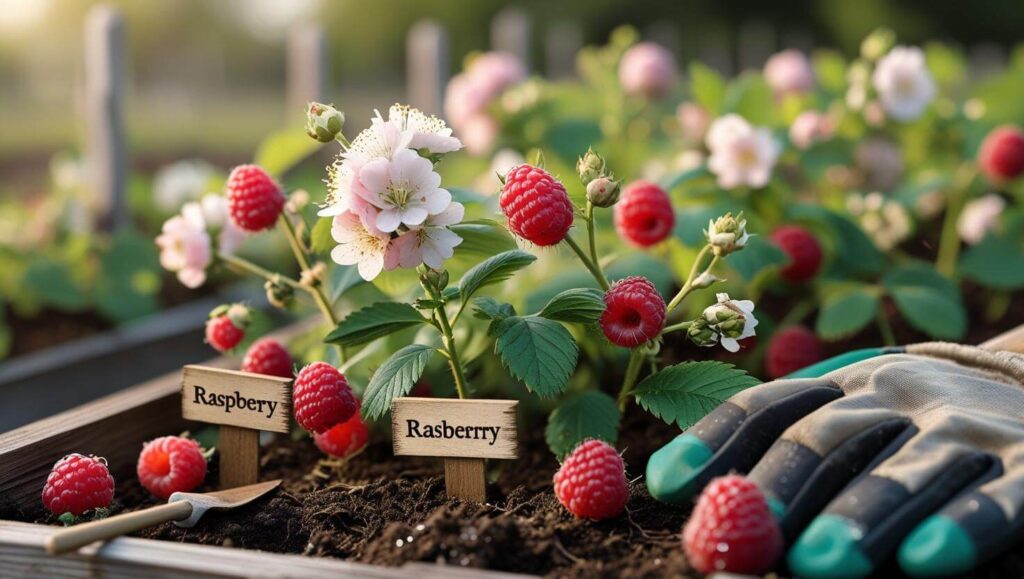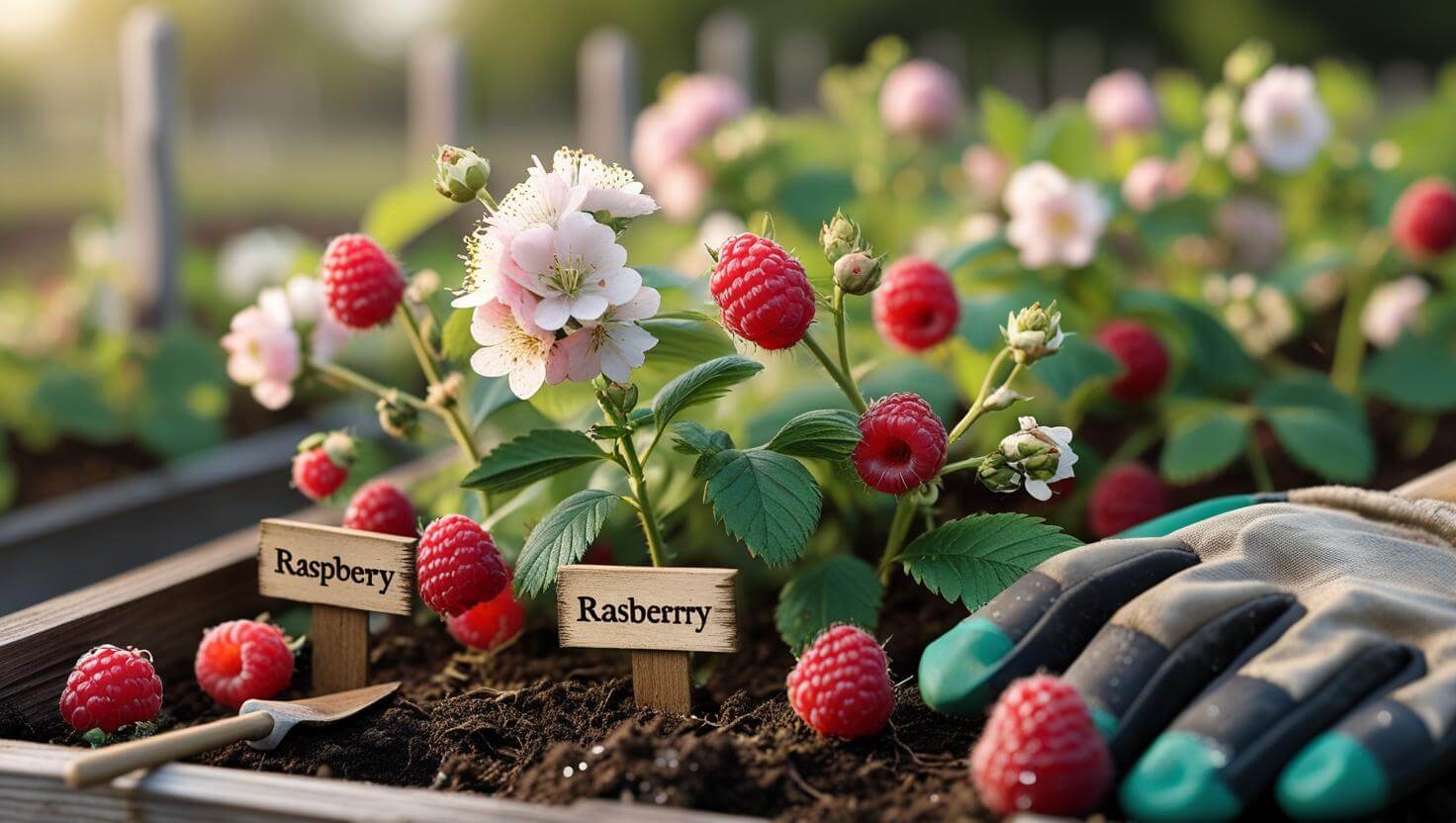As an Amazon Associate, I earn from qualifying purchases.
Growing raspberries in your garden has always been one of my favourite hobbies. Not only do raspberries offer a burst of flavour, but they’re also surprisingly easy to grow if you know the proper techniques. When I first decided to grow raspberries, I conducted extensive research to understand what it takes to achieve a successful harvest.
From selecting the right variety to caring for the plants, I discovered that with just a little effort, you can enjoy fresh, sweet raspberries from your garden. In this article, I’ll share everything I’ve learned on how to grow raspberries, including the best
What Are the Best Varieties of Raspberries to Grow?
Before starting your raspberry garden, it’s essential to choose the right variety. There are two main types of raspberries: summer-bearing and ever-bearing.
- Summer-bearing raspberries produce one large harvest in early to mid-summer.
- Ever-bearing raspberries (also called fall-bearing) produce two harvests: one in the summer and another in the fall.
Both types have their benefits, but the choice depends on your personal preference and how much fruit you want to harvest. If you have limited space, ever-bearing raspberries are a great option because they grow well in small areas and provide two harvests in one season.
Which type would you prefer in your garden? Summer-bearing for a single big harvest or ever-bearing for two smaller harvests?
How to Choose the Right Location for Raspberries
Raspberries need a lot of sunlight to thrive. Select a spot in your garden that receives at least 6-8 hours of sunlight daily. The more sunlight they get, the sweeter and larger the fruit will be. Additionally, ensure the soil drains well. Raspberries do not like sitting in wet soil, as this can lead to root rot. A raised bed or a hill can help ensure good drainage if your garden soil is heavy or clay-like.
If you live in a region with cold winters, plant raspberries in a south-facing spot, which will provide warmth and protect them from harsh winds. For those in hotter climates, some shade during the afternoon can help prevent the plant from overheating.
How to Prepare the Soil for Planting
Raspberries grow best in well-drained soil that is rich in organic matter. Aim for a pH level of 5.5 to 6.5, which is slightly acidic. You can test your soil’s pH with a kit available at any gardening store.
- Amend the soil with compost or well-rotted manure to improve soil fertility. This helps the plant develop strong roots and produce healthy fruit.
- Loosen the soil to a depth of about 12 inches before planting. Raspberries need room to spread their roots.
Did you know? Raspberries grow best in soil rich in nutrients, which helps them produce more fruit.

Planting Raspberries
Once you’ve selected the correct location and prepared the soil, it’s time to plant your raspberries. Here’s how:
- Spacing: Space the raspberry plants 2-3 feet apart in rows that are 8-10 feet apart. This allows enough room for the plants to spread out and grow.
- Planting depth: Dig a hole deep enough for the roots to be covered, but be careful not to bury the crown (the top part of the plant). The roots should be spread out in the hole.
- Planting time: The best time to plant raspberries is in early spring or fall. This gives them time to establish their roots before the hot summer months or the cold winter.
Watering Raspberries
Raspberries need a consistent amount of water, especially during the growing season. They like moist, but not soggy soil. A good rule of thumb is to water the plants once a week unless it’s particularly hot, in which case you may need to water more frequently.
Using drip irrigation can help keep the soil moist without overwatering, as it delivers water directly to the roots. Try to avoid getting the leaves wet, as wet foliage can lead to fungal diseases.
How to Support Raspberry Plants
Raspberry plants grow tall and need support to keep the canes upright. You can create a simple trellis or use a wire fence to support the plants. If you choose a trellis, install it as soon as you plant the raspberries, ensuring that the canes will have something to grab onto as they grow.
- Prune regularly: Remove any old canes that have already borne fruit. For summer-bearing raspberries, cut them back after they produce their fruit.
- Tie the canes to the trellis or support structure using garden twine. This helps prevent the canes from falling over or breaking.
How to Fertilize Raspberries
Raspberries are heavy feeders, meaning they need lots of nutrients to grow and produce fruit. Fertilize them in early spring when new growth begins. Use a balanced fertilizer or compost to provide essential nutrients.
In the growing season, you can also apply a fish emulsion or seaweed extract every 4-6 weeks to give your plants a nutrient boost. Avoid using high-nitrogen fertilizers, as they can cause the plants to grow too much foliage and not enough fruit.
How to Prune and Maintain Raspberries
Pruning is an important step in caring for raspberries. Pruning encourages healthy growth, improves airflow, and helps the plant produce more fruit.
- Summer-bearing raspberries: After the fruiting season, remove the canes that produced fruit, as they won’t fruit again. Thin out the remaining canes to about 6-8 strong canes per plant.
- Ever-bearing raspberries: Prune back all canes in the fall after harvesting the second crop. This encourages new canes to grow in the spring for another harvest.
Tip: Pruning should be done with sharp garden shears to make clean cuts and prevent spreading diseases.
Harvesting Raspberries
Raspberries are ready to harvest when they are fully ripe, which means they are bright red (or gold for some varieties) and easily detach from the plant. Gently pull the fruit from the stem, and it should come off with a bit of pressure.
Harvest your raspberries early in the morning when they are cool to avoid crushing them. If you plan to store the raspberries, place them in a single layer in a shallow container and refrigerate them immediately. Fresh raspberries can last for about 3 to 4 days in the refrigerator.
Common Problems and Solutions
Like any plant, raspberries can face some challenges. Here are a few common problems and how to solve them:
- Pests: Aphids, spider mites, and raspberry beetles are common pests. Use natural pest control methods, such as neem oil or insecticidal soap, to manage these pests.
- Diseases: Raspberries can be affected by fungal diseases such as rust or powdery mildew. Avoid overhead watering to keep the leaves dry and remove any infected leaves promptly.
- Poor fruit production: If your raspberries aren’t producing much fruit, it could be due to poor soil or insufficient sunlight. Ensure the plants receive sufficient light and nutrients.
Frequently Asked Questions (FAQs)
Q1: How long does it take for raspberries to produce fruit?
A1: Raspberries usually produce fruit in about 1-2 years after planting, depending on the variety.
Q2: Can raspberries grow in containers?
A2: Yes, raspberries can be grown in containers. Ensure the container is large enough to accommodate the roots and provide adequate drainage.
Q3: How do I prevent diseases in raspberries?
A3: Prevent diseases by avoiding overhead watering, pruning regularly, and ensuring good airflow around the plants.
Conclusion
Growing raspberries in your garden is a fun and rewarding experience. With the right care, you can enjoy delicious, fresh berries every season. Remember to select the right variety for your climate, prepare your soil properly, and provide your plants with ample sunlight and water. By following these simple steps, you can enjoy a fruitful harvest of raspberries right from your garden.
Have you thought about growing raspberries in your garden this season? What tips do you have for new gardeners? Let us know in the comments below!

